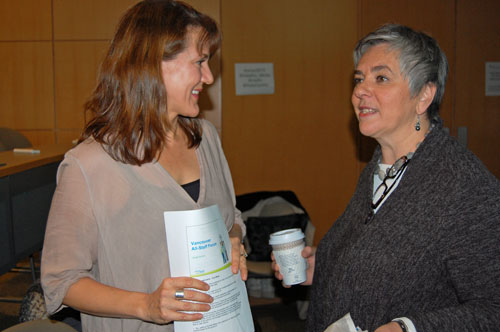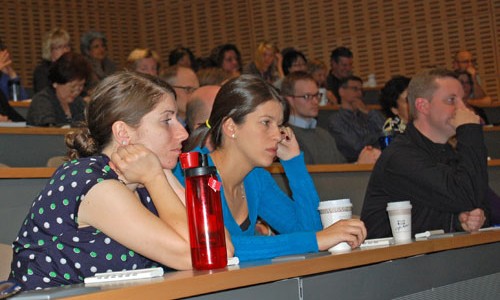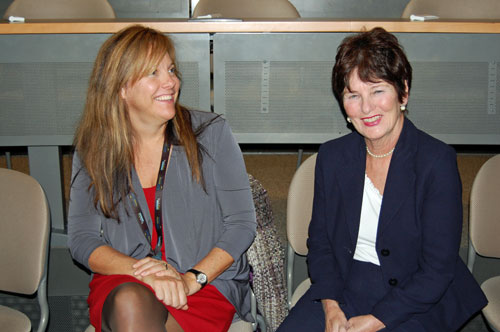Staff questions make for lively All-Staff Forum
Thank you, everyone, for making Vancouver’s All-Staff Forum a success. More than 360 (and counting) Vancouver Acute and Community staff and physicians participated. We know you’re busy people and we’re grateful you could take part.

Employee Engagement advisor Lori Benning (left) chats with Vivian about our People First survey results.
A forum built around your suggestions and questions
We promised we’d build October’s forum around your suggestions and questions — and we’re glad we did! Thanks to staff input, the conversation — and questions — were non-stop. We didn’t have enough time to answer all questions, and we didn’t always have the information on hand to answer some questions in the detail we would like, so we remain committed to answering your questions thoroughly right here in VCH News.
Email your question any day or night to: VancouverAll-StaffForum@vch.ca.
You can still experience the forum
The forum’s recorded webcast is available for viewing at the following links (Classic Viewer version is compatible with older browsers):
- Vancouver All-Staff Forum – October 2013 – (Sliver Light Player)
- Vancouver All-Staff Forum – October 2013 – (Classic Viewer Player)
The next Vancouver All-Staff Forum will be held in 2014 — please stay tuned. In the meantime, check out our latest batch of answers below.

Mary Ackenhusen, chief operating officer for Vancouver, provided an update on our budget challenge and explained why more change is still ahead.
Today’s answered questions
Q: My question is about how you might get input from us, who work in mental health, regarding ideas, strategies for coping/planning in light of the budget restraints and how to manage mental health demands in the community. We are on the frontline and many could have some great ideas about how to meet these demands differently. Personally, I think we could have a half-day MH working forum where we address these issues and come up with creative options. If the staff is included in problem-solving, they’re most likely to support the efforts of management to address these pressures.

Since the first All-Staff Forum in July, Vivian and Laura have answered more than 50 questions — and they’ll keep answering your questions as long as they keep coming in.
A: We agree! We need staff input and everyone’s collective wisdom if we’re to tackle the growing demand for mental health and addiction services in the community.
To this end, MH&A directors Anne McNabb and Andrew MacFarlane are already pulling together facilitated sessions for early Spring 2014. These sessions will be held at VGH and will likely be focused on how the MH&A teams and units are working together to meet the needs of clients and families. Time will also be dedicated to brainstorming around ideas and opportunities around addressing our budget challenge.
On a broader note, Gallup (People First survey) just asked whether or not staff feel as if they’re listened to. We want you to know that we’re all ears. We’re always open to receiving your feedback and ideas directly.
So, please, the next time you see one of us on one of our Gemba walks, introduce yourself and offer-up your suggestions. We look forward to opening the lines of staff communication further.
Q: With the controversial move by VIHA to replace 122 nurses (LPN’s and RN’s) with care aides in Victoria hospitals, does VCH have any plans to enact the same? What evidence are you using to guide and support your decision?
A: At this time, we don’t have plans to significantly shift our nursing mix within Vancouver. However, we should note that UBC Hospital adjusted its staffing mix in the summer with the addition of acute LPNs in the surgical ward.
We adjust staffing models regularly – regardless of budget constraints – to ensure our staffing mix is an appropriate match for a unit’s population. Acuity changes on units and we must ensure we have the right mix of staff for the right mix of patients to provide safe quality care.
Whenever we consider adjustments to a staffing model, we review information about the patient care needs and engage teams, including professional practice and the unions, to match those needs to the competencies of the appropriate staff.
All nurses contribute to patient-centered care, and we believe that when we work in a culture of respect, effective communication and shared decision-making, each member of the nursing discipline can make a positive difference and enhance patient care.
Q: After redevelopment, will GPC residents have access to the services that they have now, such as physio, OT, recreation, music, computer services? Will these services be provided in-house?
A: Yes, these services will continue to be provided in-house to residential care clients who live on the redeveloped George Pearson site. All will continue to have access to physio, OT, RT, speech, SW and recreation therapies. These services will not change.
On the supportive housing side of the new facility — this is where clients can choose to live more independently and arrange their own activities and supports — we will work with clients to arrange community access for these services. For example, at nearby Community Health Centres.
Q: Vancouver Acute Services did very well in our most recent accreditation but the accreditors did notice that we do not have a well consistent employee feedback process. This process has historically been called an employee performance review and/or continuous feedback. Can you share any plans to address this gap and does the plan include both operations and practice collaborating in this process?
A: Yes, we can! Employee Engagement has worked with Royal Roads University to develop a process called “Continuous Communication”. It consists of a 20-minute conversation with each employee structured around four questions:
- what’s working well
- performance achievements and recognition
- skill and career development
- ideas for process improvements and discussion about operational challenges
A pilot project of this process was conducted in a few units in 2009 and 2010, and it worked very well. Unfortunately, with the large spans of leadership managers experience (the average in acute care and residential is 150 direct reports), many manages were not able to allocate the time to fit these meetings in.
It’s been proposed that this will be one of the duties of the new OR head nurses at VGH. If it works there, it may be that both head nurses and “Continuous Communication” become part of our future.



Sophia Woo
Measuring the bottom line from transitioning to a 7.5 hour – 5 days per week schedule.
A goal of the transitioning process from a 36 hour work week to a 37.5 hour work week was to build schedules that “optimizes the consistent access to services for our clients and patients”. With respect to in-house based community mental health services this was translated as increased accessibility to services over a 7.5 hour – 5 days per week schedule from an 8 hour – 9 day fortnight schedule.
Of interest is the efficiency of actual service delivery of the 37.5 hours in terms of:
1. Total hours allocated to the 7.5 hour – 5 days per week schedule;
2. The service provided in terms of scheduled contact hours with clients and patients.
A comparator would be the same measures for the 36 hour work week.
The matter of measuring consistent access to services presents an equity issue as the 7.5 hour day re-directs coverage to clients, patients, and their families available during the day and inconveniences, perhaps cuts out those working or in school. Albeit an approximation is:
1. The early and late contacts accommodated by the ‘book ends’ provided in the 8 hour day.
2. The number of staggered schedules in the 7.5 hour – 5 days per week.
These measures do not address the team aspect of doctor provided services, and disruption to seamless delivery of mental health services.
But they will go some way to promoting the transition and loss of scheduled days off of by a committed staff.
Thanks again,
Sophia Woo, MSW,
South Mental Health Team
Sophia Woo
Bridging PARIS to Patient Care Information System and Care Connect
In order to save time from computer choirs, the Integrated Client Information Viewer is coming on stream.
It is designed to reduce the time required to access material on clients available in PARIS.
Another issue that needs to be addressed is to extend the connection of PARIS through a bridge to Patient Care Information System and Care Connect.
What is required is a simple artificial intelligence component constrained on a “need to know” basis to focus attention of community case managers to ongoing activities such as hospital admission, transfer, registration and discharging.
Operationally the task seems not that complicated and could both save time and increase reliability of patient care. Why is notification of transfer, etc. still initiated as a new task when a systematic procedure could speed up the process and avoid complications?
Sophia Woo
Sophia Woo
1) What changes in public finance would VCH require to implement a 10 year agreement with staff?
Currently the K-12 education sector is undergoing changes in governance and negotiating for a 10 year agreement with teachers. This will require a restructuring of the public finance regime so as to avoid wage reopeners amongst other factors.
Changes required to accommodate a ten year term will undoubtedly alter the current service delivery model in fundamental ways, most notably public finance. Some differences in the financial regime between VCH and K-12 sector are apparent.
VCH is required to zero out its budget March 31st , similar to other sectors. The education sector K-12 school board budgets already have one of the requirements for long term arrangement – budgets permit ‘surplus’ to be carried over for multiple years. The ‘surplus’ includes funds actually dedicated to purchases that have yet to be delivered, shareable capital allocations, and actual unallocated funds.
What other changes in public finance would VCH require to implement a 10 year agreement with staff?
Sophia Woo